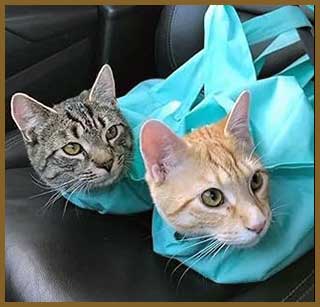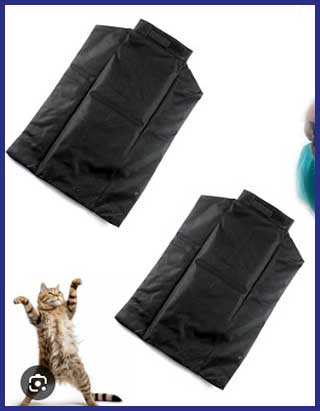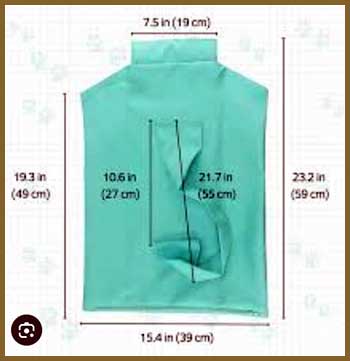As a long-time cat owner and someone who’s tried countless pet carriers over the years, I recently gave the Aberfields Cat Carrier a shot.
After seeing mixed reviews online and hearing about it from fellow cat parents, I wanted to test it myself and share my experience with you. If you’re considering this carrier, you’ll want to read this detailed review before making your decision.
My Experience Using The Aberfields Cat Carrier

I’ll be completely honest with you – getting my cat into this carrier was more challenging than I anticipated. The design requires you to guide your cat through the bag toward a relatively small head opening, which proved to be quite stressful for both of us.
My cat Lucy, who typically tolerates carriers reasonably well, showed clear signs of distress during our attempts.
The ergonomic harness, while well-intentioned, didn’t distribute weight as effectively as claimed. During our brief usage, I noticed the carrier didn’t feel as secure as traditional hard-shell carriers or even other soft carriers I’ve used in the past.
First Impressions And Design
When I first received the Aberfields Cat Carrier, I was intrigued by its unique design. The canvas material felt sturdy in my hands, and the breathable holes seemed promising for good ventilation.
The manufacturer markets it as a multi-functional carrier that can double as a grooming restraint and everyday bag. I particularly liked the idea of having a carrier that could serve multiple purposes.
However, my excitement started to wane as I examined the product more closely. The head opening, which is crucial for getting your cat in and out safely, appeared smaller than expected. As someone who’s dealt with various carriers over the years, I immediately recognized this could be problematic.
Aslo Read: My Thought on Sweety Fox High Chair
Design Features And Specifications
The carrier comes with several notable features:
- A canvas construction with ventilation holes
- An ergonomic harness design
- A weight capacity for cats between 10-15 pounds
- A convertible design for grooming purposes
- Additional storage capabilities
While these features sound good on paper, I found some significant issues during practical use. The canvas material, though breathable, isn’t as resistant to cat claws as I’d prefer. I noticed my cat Lucy was able to catch her claws in the fabric rather easily, which concerned me about the carrier’s long-term durability.
The Reality Check: Major Concerns
Through my testing and research, I’ve identified several significant issues that potential buyers should consider:

The entry mechanism is problematic. Unlike traditional carriers with wide side openings, this design makes it unnecessarily difficult to get your cat in and out safely. I found myself struggling even with my relatively calm cat, and I can only imagine how challenging it would be with a more anxious pet.
The size specifications are misleading. While it’s marketed for cats between 10-15 pounds, I found the space quite restrictive even for my 11-pound cat. The confined space could make longer trips particularly uncomfortable for your feline friend.
The construction quality raises durability concerns. During our testing period, I noticed stress points in the fabric where cat claws could potentially tear through the material. This isn’t just about longevity – it’s A Safety Concern That You Need To Consider.
How It Compares To Other Cat Carriers
I’ve tested numerous carriers over the years, and I want to share how the Aberfields stacks up against popular alternatives. The traditional hard-shell carriers like the Petmate Sky Kennel provide significantly better protection and security. Even budget-friendly options like the Amazon Basics Soft-Sided Carrier offer more practical entry systems with their wide side openings.
While the Aberfields tries to stand out with its multi-functional design, carriers like the Sherpa Original Deluxe or the Sleepypod Mobile Pet Bed deliver better on their promises. These alternatives might cost more, but they provide superior quality, durability, and, most importantly, stress-free experiences for both cats and owners.
Read More: My Thought on Ozzie Smoke Remover
Maintenance And Care Tips
If you already own this carrier or still plan to purchase it despite the concerns, here are some essential maintenance tips I’ve learned:
Regular inspection is crucial. Check the stitching and fabric integrity before each use, paying special attention to areas where your cat’s claws might have created weak points. The canvas material needs frequent cleaning – I recommend spot cleaning with mild soap and water, followed by thorough air drying.
The velcro fasteners require regular cleaning to maintain their effectiveness. Remove any accumulated fur or debris to ensure proper closure. I’ve found that a small brush works well for this purpose.
The Bottom Line: My Recommendation
After spending several weeks testing the Aberfields Cat Carrier in various situations, I feel compelled to share my detailed thoughts on why this product may not be your best choice. I’ve transported cats for over a decade, and I understand how crucial a reliable carrier is for both pet and owner peace of mind.
The fundamental issues with the Aberfields carrier stem from its ambitious but flawed design approach. While I appreciate the attempt to create a multi-functional product, the execution compromises essential carrier functions. The small head opening, which is meant to be innovative, actually creates unnecessary stress during loading and unloading. I watched my usually calm cat become increasingly anxious with each use, which is exactly what you don’t want in a carrier.
The durability concerns I encountered are particularly worrisome. During my testing period, I noticed several weak points in the canvas material where my cat’s claws created visible stress marks. For a product that’s meant to secure your pet during transport, any potential compromise in the material integrity is a serious red flag. I’ve seen far too many similar products fail at crucial moments, and I wouldn’t want any fellow cat owner to experience that anxiety.

Size specifications also proved problematic in real-world use. My cat, who falls well within the advertised weight range of 10-15 pounds, seemed cramped in the carrier. I observed her struggling to find a comfortable position, which is especially concerning for longer journeys. A carrier should provide enough space for your cat to turn around and lie down comfortably – basic requirements that this product doesn’t quite meet.
The ventilation system, while present, isn’t as effective as traditional carrier designs. During warmer days, I noticed the interior becoming quite warm despite the breathable canvas and ventilation holes. This could be particularly problematic during summer travel or in warmer climates. Your cat’s comfort and safety should never be compromised, especially when there are better alternatives available.
Price-wise, the Aberfields sits in a middle range that makes its shortcomings even harder to justify. For the same investment or even less, you could obtain a carrier that excels at its primary function rather than trying to be a jack-of-all-trades. I’ve found that specialized products often provide better value than those attempting to serve multiple purposes.
The grooming restraint feature, while innovative in concept, doesn’t provide enough security for actual grooming sessions. I attempted to use it for nail trimming, and the experience was far from ideal. The material didn’t provide enough control, and the overall design made it difficult to access my cat’s paws safely. You’re better off using dedicated grooming tools or seeking professional services for these tasks.
From a practical standpoint, the carrier’s storage capabilities when not in use for pet transport are limited. The design compromises make it less effective as a regular bag, and the specialized features become cumbersome when trying to use it for general storage. I found myself reaching for my regular bags instead, making this feature essentially redundant.
If you’re in the market for a cat carrier, I strongly recommend considering alternatives that focus on doing one thing exceptionally well rather than multiple things adequately. Look for carriers with wide, secure side openings, sturdy construction, and proper ventilation. Traditional hard-shell carriers or well-designed soft carriers from established pet brands will serve you better in the long run.
Your cat’s carrier is essentially their safe space during travel, veterinary visits, or emergencies. It needs to be reliable, easy to use, and stress-free for both you and your pet. While the Aberfields attempts to revolutionize the traditional carrier design, it unfortunately misses these crucial marks. The stress of struggling with entry and exit, concerns about material durability, and limited space make it difficult to recommend this product when there are proven alternatives available.

Remember, a good carrier should make your life easier, not more complicated. It should provide security and comfort for your cat while being practical for you to use. Based on my extensive testing and years of experience with various carriers, I recommend looking at other options that better meet these essential criteria. Your cat’s safety and comfort, along with your peace of mind, are worth the investment in a more reliable product.
Frequently Asked Questions
From my experience and research, the best type of carrier depends on your specific needs. Hard-shell carriers offer superior protection and are excellent for long trips or vet visits. Soft-sided carriers work well for shorter journeys and cats who prefer more flexible surroundings. The key is choosing one with adequate ventilation, secure closures, and easy access.
I’ve found that this largely depends on your individual cat’s personality. Some cats feel more secure in rigid, enclosed spaces (hard carriers), while others prefer the flexibility of soft carriers. The most important factor is that the carrier feels safe and comfortable for your cat, regardless of the material.
In my experience, cats should not spend more than 6-8 hours in a carrier at a time. For longer journeys, you should plan breaks where your cat can use a litter box and drink water. Always monitor your cat for signs of distress and adjust travel plans accordingly.
The safest spot for your cat’s carrier in a car is on the floor behind the front passenger seat or secured in the back seat with a seatbelt. Never place the carrier in the front seat where it could be affected by airbag deployment. The carrier should be positioned to minimize movement during the journey.
Final Thoughts
In the world of pet carriers, innovation is always welcome, but not at the expense of functionality and safety. The Aberfields Cat Carrier attempts to solve several problems at once but unfortunately creates new ones in the process. Its multi-purpose design, while creative, compromises the basic requirements of a reliable cat carrier.
For those still searching for the right carrier, I encourage you to prioritize your cat’s comfort and security above all else. Consider your specific needs – whether you’re planning long trips, regular vet visits, or just want a reliable carrier for emergencies. Your choice should make transport easier for both you and your feline friend, not add unnecessary stress to the experience.
